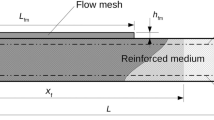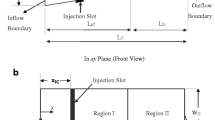Abstract
The behavior of glass-fiber reinforced phenolic resin in the presence of the wall surface during injection molding under various processing parameters has been studied with a rather simple but effective and useful method, namely, the spotwise painting of the mold wall surface. The experimental results show clearly a strong slip of the phenolic melt on the cavity surface. The occurrence of slip begins immediately when the phenolic melt contacts the wall surface. This technique was applied to study the slip of thermoplastic melts inside a rectangular mold. However, completely opposite results found between the flow behavior of thermosets and thermoplastics on the cavity surface raise the questions concerning the applicability of thermoplastics injection molding concepts and rheological property testing methods, respectively, simulation packages for thermosets.
Similar content being viewed by others
References
Zheng R, Tanner R, Fan XJ (2011) Injection molding: integration of theory and modeling methods. Springer Berlin Heidelberg, Germany. https://doi.org/10.1007/978-3-642-21263-5
Gerd P, Walter M (2008) Injection molding: an introduction. Carl Hanser Verlag, Munich
Nguyen-Chung T, Plichta C, Mennig G (1998) Flow disturbance in polymer melt behind an obstacle. Rheol Acta 37(3):299–305. https://doi.org/10.1007/s003970050117
Nguyen-Chung T (2004) Flow analysis of the weld line formation during injection mold filling of thermoplastics. Rheol Acta 43(3):240–245. https://doi.org/10.1007/s00397-003-0339-2
Singh R, Chen F, Jones FR (1998) Injection molding of glass fiber reinforced phenolic composites 2: study of the injection molding process. Polym Compos 19(1):37–47. https://doi.org/10.1002/pc.10073
Thienel P, Hoster B et al (1993) Duroplast-spritzgießen mit gasinnendruck, vol 83. Carl Hanser Verlag, Munich, pp 91–95
Ohta T (2001) Visual analysis of cavity filling and packing process in injection molding of thermoset phenolic resin by the gate-magnetization method. Polym Eng Sci 41(5):806–819. https://doi.org/10.1002/pen.10778
Yokoi H, Hayashi T, Morikita N, Todd K (1988) Direct observation of jetting phenomena under a high injection pressure by using a prismatic-glass inserted mould. Proceedings of the SPE Annual Technical Conference ANTEC, Atlanta, USA 88: 329–333
Englich S (2015) Strukturbildung bei der Verarbeitung von glasfasergefüllten Phenolformaldehydharzformmassen. PhD Thesis, Chemnitz University of Technology, Germany
Acknowledgements
The first author acknowledges the meaningful discussions with Prof. Dr. G. Mennig and Dr. Tham Nguyen-Chung on injection molding theory.
Author information
Authors and Affiliations
Corresponding author
Rights and permissions
About this article
Cite this article
Tran, N.T., Englich, S. & Gehde, M. Visualization of wall slip during thermoset phenolic resin injection molding. Int J Adv Manuf Technol 95, 4023–4029 (2018). https://doi.org/10.1007/s00170-017-1524-2
Received:
Accepted:
Published:
Issue Date:
DOI: https://doi.org/10.1007/s00170-017-1524-2




